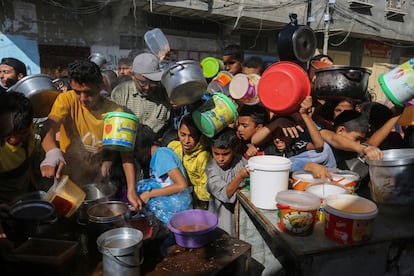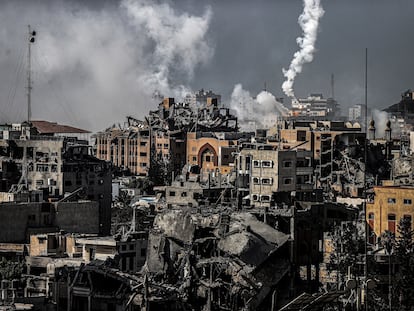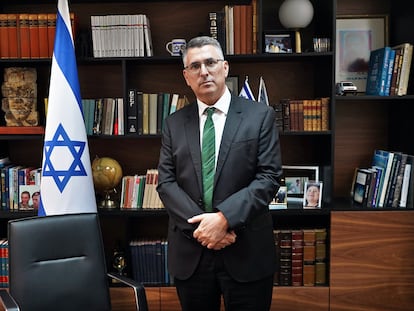Only a trickle of humanitarian aid entering Gaza: ‘It’s a drop in the bucket’
Only 700 trucks have been able to enter since October 21, which represents just 11% of the supplies that the enclave received before the Hamas war. The strict conditions imposed by Israel are creating bottlenecks at the Rafah border crossing

Humanitarian aid is arriving in the Gaza Strip, but not enough to address the catastrophe that is devastating the Palestinian enclave. A month after Israel announced its total blockade of Gaza in parallel to its devastating military offensive, diplomatic efforts have so far only succeeded in opening an intermittent corridor for the delivery of essential supplies — limited to food, water and medicine — through the Rafah border crossing between Gaza and Egypt. But the conditions imposed by Israel in exchange for allowing humanitarian convoys to enter Gaza are creating bottlenecks and stopping more aid from arriving.
Since the trickle of aid began flowing through Rafah on October 21, only around 700 trucks have been able to access Gaza, according to a count by the U.N. Office for Humanitarian Affairs (OCHA). In the first half of the year, an average of 9,500 trucks entered per month, meaning in the last 20 days, Gaza has only received 11% of what it did before the war. The reduced aid means that residents in the Gaza Strip are finding it increasingly difficult to find food and water for their survival. What’s more, Israel has banned fuel shipments, and hospitals in the north of the enclave are having to perform complex operations, including amputations, without anesthesia, according to U.N. agencies. The Kerem Shalom crossing, between Gaza and Israel — which was the main port of entry for goods into Gaza before the total blockade — remains closed.
“The aid getting through is a trickle, and with severely limited geographical reach,” said the U.N. High Commissioner for Human Rights, Volker Türk, on Wednesday, while visiting Rafah. Türk urged Israel, “as the occupying power,” to ensure that basic necessities reach all who need it, as the people in Gaza “remain deeply vulnerable.”
The prosecutor of the International Criminal Court (ICC), Karim Khan, warned that preventing the delivery of humanitarian aid may constitute a war crime, and has stressed that Israel must ensure that Gazans receive food, water and medical supplies. The U.N. Secretary General, António Guterres, said on Monday that “life-saving aid” is getting into Gaza, but warned “the Rafah crossing alone does not have the capacity to process aid trucks at the scale required.”
“The amount of aid coming in is a drop in the bucket of Gaza’s humanitarian needs,” said Mey al Sayegh of the International Federation of Red Cross and Red Crescent Societies (IFRC). “Before this conflict, about 100 trucks of aid alone entered Gaza [a day]. So imagine now, with all the hostilities going on, if only this number is coming in.”
Aid deliveries through the Rafah border were disrupted at the start of the conflict after Israel bombed the site three times in less than 24 hours, causing extensive damage to the Palestinian terminal of the crossing. The bombardment happened just after Israel announced its complete siege on Gaza, which is home to two million people. Between then and the partial reopening on October 21, Israel did not offer security guarantees to allow humanitarian aid convoy to enter Gaza.
In an attempt to pressure Israel to allow the entry of aid, three days after the siege of Gaza was announced, Egypt designated El Arish international airport as the logistics center to receive supplies destined for the Palestinian enclave. Since then, shipments from multiple countries, U.N. agencies, the European Union and the Red Cross have landed at the airport, which is located around 28 miles from Rafah.
Biden visit
The situation in Rafah began to ease after U.S. President Joe Biden visited Israel on October 18. That night, the Jewish state announced that it would continue to block the entry of humanitarian aid from its territory, but that it would not prevent aid from Egypt as long as it was limited to food, water and medicine for the civilian population in the south of Gaza, and that it did not reach Hamas or include fuel.
Reem Nada, a spokesperson for the World Food Program (WFP) in Cairo, noted: “Negotiations for continued and sustained aid delivery continue, and many humanitarian partners, U.N. agencies and the Egyptian Red Crescent are working around the clock to make it happen. But the green light for such a move is never guaranteed.”
All convoys entering Gaza through Rafah must now first go to the Nitzana crossing, between Egypt and Israel and 25 miles south of Rafah. The trucks are inspected by Israeli authorities at their border post terminal, and then return to Rafah to enter Gaza. A spokesman for the Israeli Defense Ministry unit in charge of coordinating civil affairs in the occupied Palestinian territories (COGAT) said that humanitarian supplies can enter Gaza on the condition that the equipment is “inspected by Israeli security personnel before entering Gaza.”
Reem Nada, from the WFP, points out that her organization and other U.N. agencies and NGOs have “all kinds of humanitarian aid,” but continue to “wait for the green light to enter Gaza.” Martin Griffiths, the U.N. humanitarian aid coordinator, proposed establishing a random inspection system, similar to that used between Turkey and northwest Syria, to speed up the process, but the idea did not move forward. The number of trucks crossing Rafah has increased slightly since early November, but still just over 100 enter each day.
The slow process is creating bottlenecks in El Arish, where large quantities of humanitarian supplies are waiting. Qatar also said that it has paused shipments to Egypt so as not to overwhelm El Arish. And Al Sayegh, from the IFRC, notes that food and medicine expiration dates need to be monitored.
Nearly 90 UN workers have died in Gaza
The challenges also do not end once the humanitarian convoys cross Rafah, since there is no geographically delimited ceasefire within Gaza to distribute aid safely, as had initially been requested. So far, 89 workers from the U.N. agency for Palestinian refugees (UNRWA) have died in Gaza.
Furthermore, Israeli bombings have also caused significant damage to the roads connecting the Rafah crossing with the rest of Gaza, and Israeli authorities have explicitly prohibited the distribution of humanitarian aid in the northern Gaza, where residents have been forcibly displaced to the south.
“These decisions should not be made by Israel; it is not Israel that should decide how aid is distributed, but the humanitarian actors,” said Miriam Marmur, director of public advocacy at Gisha, an Israeli organization that ensures freedom of movement in Palestine, especially for residents of Gaza.
In previous Israeli military offensives on Gaza, temporary closures of border crossings had also been ordered, Marmur notes. But she notes that, in recent years, the escalations of violence were shorter and at times “some aid” was allowed in. She describes the current situation as “unprecedented” both with respect to how long the border has been closed for, and how restrictive it is.
Sign up for our weekly newsletter to get more English-language news coverage from EL PAÍS USA Edition
Tu suscripción se está usando en otro dispositivo
¿Quieres añadir otro usuario a tu suscripción?
Si continúas leyendo en este dispositivo, no se podrá leer en el otro.
FlechaTu suscripción se está usando en otro dispositivo y solo puedes acceder a EL PAÍS desde un dispositivo a la vez.
Si quieres compartir tu cuenta, cambia tu suscripción a la modalidad Premium, así podrás añadir otro usuario. Cada uno accederá con su propia cuenta de email, lo que os permitirá personalizar vuestra experiencia en EL PAÍS.
¿Tienes una suscripción de empresa? Accede aquí para contratar más cuentas.
En el caso de no saber quién está usando tu cuenta, te recomendamos cambiar tu contraseña aquí.
Si decides continuar compartiendo tu cuenta, este mensaje se mostrará en tu dispositivo y en el de la otra persona que está usando tu cuenta de forma indefinida, afectando a tu experiencia de lectura. Puedes consultar aquí los términos y condiciones de la suscripción digital.
More information
Archived In
Últimas noticias
Chris Martin, Taylor Swift, Elijah Wood and other famous wedding ‘crashers’
‘How does it feel to be a failure?’: Elizabeth Berkley’s journey from ‘Showgirls’ ridicule to vindication
The story of the Málaga virus: The code that haunted Google’s cybersecurity center director for 30 years
The impact of Ecuador’s mega-prison: A polluted river, cleared forests and military checkpoints
Most viewed
- Christian Louboutin: ‘Young people don’t want to be like their parents. And if their parents wear sneakers, they’re going to look for something else’
- The low-cost creative revolution: How technology is making art accessible to everyone
- Liset Menéndez de la Prida, neuroscientist: ‘It’s not normal to constantly seek pleasure; it’s important to be bored, to be calm’
- All the effects of gentrification in one corner of Mexico’s Colonia Roma
- December Social Security and SSI payments: Dates, double checks and the 2026 COLA increase











































